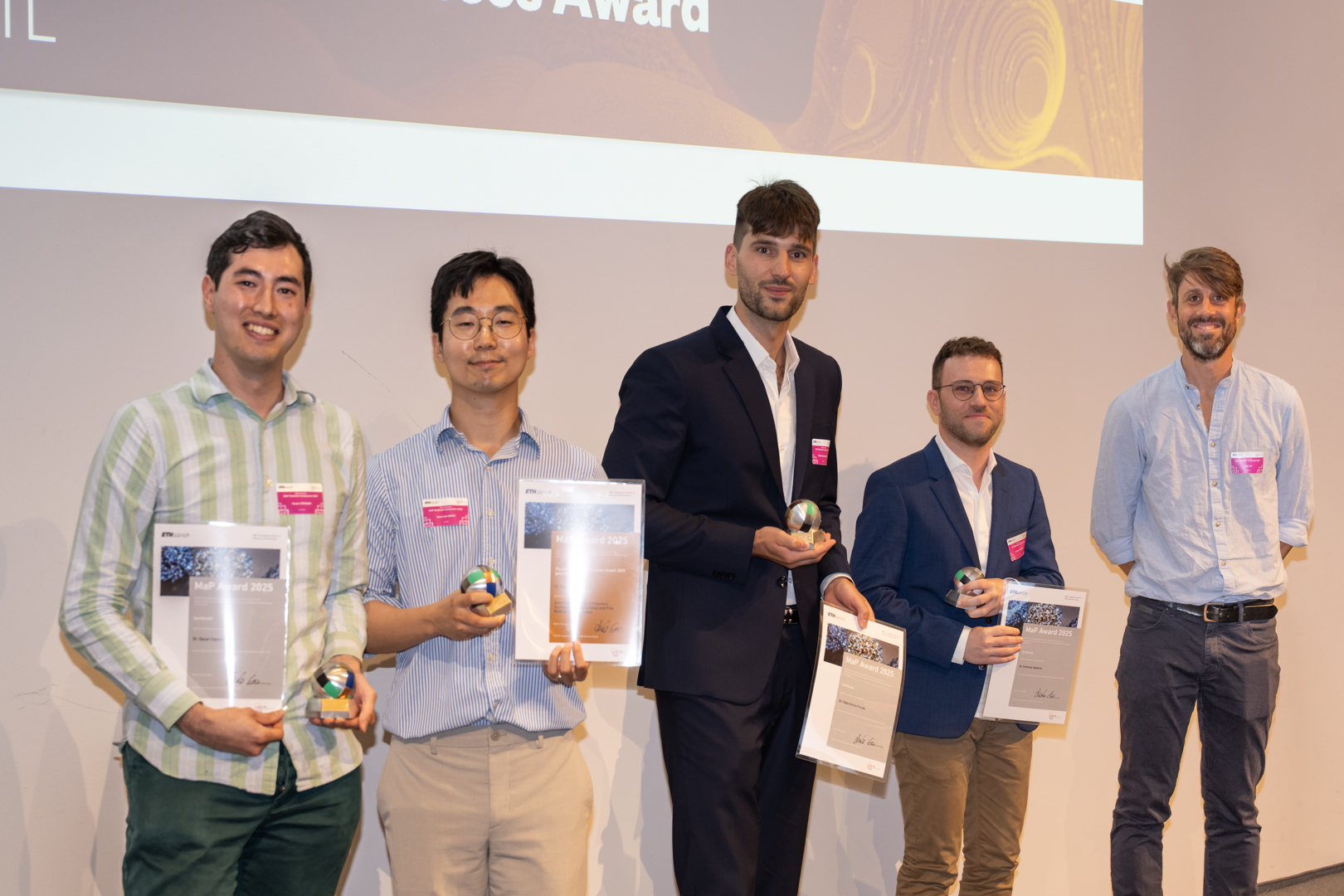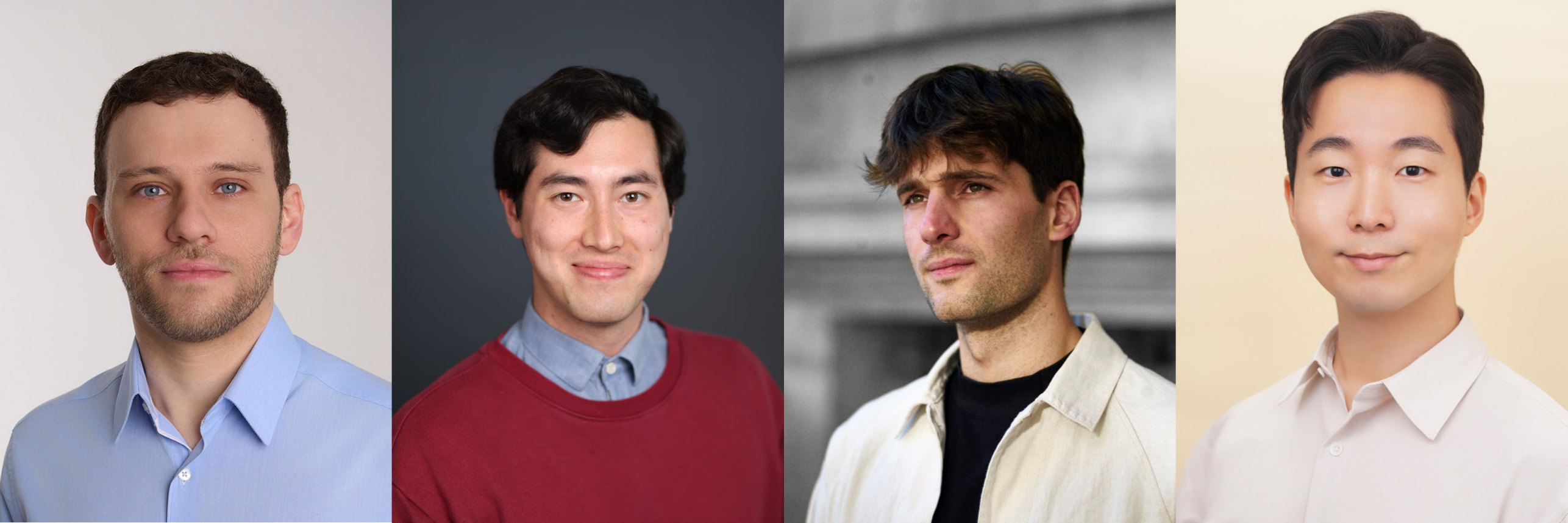MaP Award
Dr Hyun Suk Wang has been awarded the MaP Award 2025 for his outstanding doctoral research on chemically recycling plastics back to their original building blocks—an important contribution to sustainable materials science.

MaP Award Final 2025

The MaP Doctoral School is delighted to announce that Dr Hyun Suk Wang has won the prestigious MaP Award 2025 for the most outstanding doctoral thesis in the field of Materials and Processes at ETH Zurich presented in 2024.
Winner: Dr Hyun Suk Wang (Polymeric Materials, D‑MATL)
Dr Wang is recognised for his doctoral thesis “Chemical Recycling of Polymers Synthesized by Controlled and Free Radical Polymerization”. His research contributes to mitigating the growing plastic waste stream by reverting polymers to their starting materials, their monomers, at temperatures much lower than that of pyrolysis. This is achieved by activating either the end or the middle of the polymer chain under reaction conditions that thermodynamically drive depolymerization. Dr Wang receives the MaP Award puzzle ball and additionally CHF 3,000 in prize money.
Congratulations to the other MaP Award finalists
Being selected for the final is an outstanding achievement. At the MaP Graduate Symposium on 19 June 2025, four finalists delivered presentations before the MaP jury, which accounted for 20 % of the final decision. To commemorate the occasion, each finalist receives a MaP Award puzzle ball:
Andreas Apseros (Mesoscopic Systems, D‑MATL): X-ray Tomographic Imaging of the Anisotropic Orientation in Non-Cubic Crystals and Antiferromagnets in Three Dimensions
Oscar Cipolato (Nanoparticle Systems Engineering, D‑MAVT): Intelligent Laser Tissue Soldering
Fabio Enrico Furcas (Durability of Engineering Materials, D‑BAUG): Reaction Pathways of Iron in Aqueous Media
Acknowledgements
The MaP Doctoral School would like to thank the Award Jury—comprising experts from both academia and industry—for their thorough evaluation and feedback throughout the selection process. Our appreciation also goes to the organising committee of the MaP Graduate Symposium for facilitating an engaging platform for finalists, and to all participants whose work continues to enrich the MaP community.
Nominees' portraits

X-ray Tomographic Imaging of the Anisotropic Orientation in Non-Cubic Crystals and Antiferromagnets in Three Dimensions

Andreas Apseros completed his bachelor’s and master’s degrees in Natural Sciences (Physics) at the University of Cambridge. He then moved to Switzerland to pursue his doctorate at ETH Zurich in the Laboratory for Mesoscopic Systems. For this, he focused on the development of a new X-ray-based technique to perform 3D imaging and characterization of materials hosting topological structures, which are key components for future energy-efficient devices.
Your doctorate project in two sentences
The ability to image the orientation of anisotropic material properties in three dimensions is fundamental for the understanding of materials and their functionality-driven development. With the development of XL-DOT, it is now possible to non-destructively image orientation fields in extended samples with nanoscale spatial resolution, as demonstrated with the mapping of the crystallographic microstructure and antiferromagnetic configurations in 3D.
Why did you choose this doctorate project?
Following my master’s project at the University of Cambridge under the supervision of Dr. Claire Donnelly, who has made key contributions to the development of magnetic tomography, I was excited to pursue the opportunity to work on X-ray dichroic tomography. Particularly fascinating to me was the potential versatility and interdisciplinary impact of the technique, due to the nature of the linear dichroic contrast mechanism that was harnessed in my doctoral project to perform orientation tomography. In particular, linear dichroic contrast is exhibited by several different classes of materials, from biominerals to technological and energy storage materials. I could also apply a combination of skills, including software and algorithm development, along with an understanding of complex scientific methodologies in order to address key challenges in materials characterization.
Future plans
In the future, my collaborators and I would like to apply the newly developed XL-DOT technique to map the ordering of magnetic and charge anisotropies across a broad spectrum of materials in three dimensions. As 3D vector and orientation imaging is an emerging field, a large part of this effort will be the implementation and development of compatible setups at beamlines around the world so that the technique will be readily available to researchers. In the long term, we are aiming towards time-resolved, operando tomographic characterization, to provide a profound understanding of materials under working conditions, which is essential for purpose-driven materials development.
Intelligent Laser Tissue Soldering

Oscar Cipolato, born and raised in Venice (Italy), studied Physics at the University of Padova (BSc, MSc). During his academic journey, he conducted research at the DESY and Imperial College London. Then, he pursued his PhD at ETH Zurich, working in the Nanoparticle Systems Engineering Lab under the supervision of Prof. Dr. Inge Herrmann. Following the completion of his PhD, he was awarded the Empa Entrepreneur Fellowship to advance the technology developed during his doctoral research.
Your doctorate project in two sentences
Aiming to improve surgical wound closure and overcome the limitations of sutures and staples, we developed an advanced Laser Tissue Soldering technique integrating fluorescent nanothermometers and plasmonic nanoparticles for precise thermal control. The method enables safe, damage-free bonding in soft tissues and is adaptable to both minimally invasive and robotic-assisted surgeries.
Why did you choose this doctorate project?
During my studies in physics and research experience, I gained a deeper understanding of what truly excites me: exploring new concepts and approaches, seeing them applied in real-world settings, and contributing to something with a positive impact. This realization led me to seek an applied, interdisciplinary project with clear benefits for people. Prof. Herrmann's group provided the ideal environment for this. Working on laser tissue soldering was a perfect fit—it built on my background in photonics and nanotechnology, exposed me to new fields, and had a clear, inspiring vision.
Future plans
Thanks to the Empa Entrepreneur Fellowship, I now have the opportunity to explore how to bring this technology into surgical rooms and create a real impact. At the same time, I am still committed to continuous growth—both professionally and personally—by seeking new opportunities to apply my skills, develop new ones, and broaden my perspective.
Reaction Pathways of Iron in Aqueous Media

Fabio Enrico Furcas grew up in Aachen, located in the western part of Germany. In May 2020, he completed his MEng. degree in Chemical Engineering from the University of Aberdeen, Scotland. During his master thesis, he first came into contact with the captivating subject area of reactive transport modelling. Fabio decided to pursue his doctoral degree at ETH Zurich (D-BAUG) at the Durability of Engineering Materials laboratory, led by Prof. Ueli Angst. During his PhD (Sept. 2020 – Sept. 2024), he immersed himself in the complex chemical reaction pathways that govern the fate of iron in reinforced concrete structures, the immobilization of groundwater contaminants and the degradation of archaeological artefacts. Fabio currently works as a Postdoc in the Concrete & Asphalt Laboratory at EMPA, Dübendorf.
Your doctorate project in two sentences
My doctorate is concerned with iron, one of the most abundant elements on earth, and the various (hydr)oxides it forms, as well as their stability over time and under different chemical conditions. Its proclivity the react with other elements has profoundly shaped our society, from ancient metallurgy to the capture of toxic elements and the degradation of modern infrastructure.
Why did you choose this doctorate project?
The ability to predict the outcome of chemical reactions - that have bothered scientists and engineers in various disciplines for decades - through thermodynamic and kinetic modeling is truly captivating, almost like magic, for lack of a better word. My doctoral project at the Durability of Engineering Materials group provided me with an opportunity to apply my fascination to a use case that is versatile, both in terms of the broad areas of application as well as the number of chemical species and transformation pathways involved. Unifying a strong background in material science as well as interdisciplinary approaches to study the durability of engineering materials affecting our everyday life made my project stand out. I particularly cherished the flexibility to explore not just one narrow area of application, but instead apply the findings of my investigations to fields that, at first glance, appear completely unrelated.
Future plans
Although my thesis contributed a few important puzzle pieces towards a holistic understanding of the reaction pathways of iron in aqueous media, there is a lot more work to be done. In my current position at EMPA Concrete & Asphalt Laboratory, I'm trying to shed more light on some of the many open questions that I did not manage to address within my doctorate. I value the opportunity to continue learning new concepts and skills in collaboration with other researchers and passing on my knowledge to new doctoral candidates, who are slowly absorbed by the same type of fascination that has gotten hold of me a few years ago. For the years to come, I would like to continue advancing our understanding of metal transformation, tackling the major scientific challenges that impact us in many areas of life.
Chemical Recycling of Polymers Synthesized by Controlled and Free Radical Polymerization

Hyun Suk Wang received his B.Eng and M.Eng in Chemical Engineering from Korea University. He then obtained his PhD at ETH Zurich under the supervision of Prof. Athina Anastasaki as a Swiss Government Excellence Scholar. During his PhD, Hyun Suk’s research revolved around polymer chemistry and the chemical recycling of plastics through depolymerization.
Your doctorate project in two sentences
To mitigate the growing plastic waste stream, my doctorate project focused on reverting polymers to their starting materials, their monomers, at temperatures much lower than that of pyrolysis. This was achieved by activating either the end or the middle of the polymer chain under reaction conditions that thermodynamically drive depolymerization.
Why did you choose this doctorate project?
Polymer science has fascinated me since my Master’s studies, naturally leading me to pursue a doctorate in polymer synthesis. In my first year at ETH, COVID forced me out of the lab, allowing me to reflect on how my research could make a meaningful impact. I realized that leveraging polymer chemistry to deconstruct plastics was a promising avenue. With my supervisor’s support, I embarked on a journey to depolymerize polymers at low temperatures—a pursuit that began with six months of failed experiments which laid the foundation for future discoveries!
Future plans
In the short term, I plan to expand my expertise as a postdoctoral researcher by exploring a new field. Specifically, I aim to investigate mechanophore-containing materials—polymers that undergo chemical transformations under mechanical force—due to their potential to enable next-generation, responsive materials. In the long term, I aspire to integrate my knowledge of high-performance materials and the chemical recycling of commodity plastics to contribute to the advancement of sustainable polymer technologies. My goal is to help establish a research initiative that fosters collaboration between academia and industry, driving innovation in sustainable materials while supporting the chemical industry's transition toward more environmentally responsible manufacturing practices.
Previous MaP Award Finals
MaP Award 2024
MaP Award 2023
MaP Award 2022
MaP Award 2014-2021
